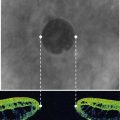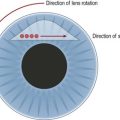CHAPTER 33 Intracorneal rings
Epidemiologic consideration and terminology
Keratoconus is a progressive disorder and usually its progression rate is higher before the fourth decade. The treatment of keratoconus, up to date, was mostly focused on visual rehabilitation. In the future, controlling the progression of the disease will be another important goal for treatment modalities to achieve. This would allow more patients to be in the older ages when the progression of the keratoconus slows down, without significant complication and visual deprivation. Although long-term results with controlled studies are not known, depending on early results, ICRS not only provide better visual quality but also may help in controlling the progression of keratoconus1,2. With the advent of cross-linking, and perhaps with the combination of both modalities, the need for keratoplasty for keratoconus, which has an approximately 20% rejection rate, will decrease. Moreover, it will be possible to help patients with advanced disease with stronger ICRS treatments and state of the art corneal lamellar surgery3.
Fundamental principles
According to the postulates of Barraquer and Blavatskaya, intracorneal ring acts as tissue addition leading to a flattening in the cornea periphery. The diameter of the ring is proportionally inverse to the flattening intensity thus, the smaller the diameter, the more tissue added (ring thickness) with the higher myopic correction4.
In keratoconus, the corneal elastic modulus is reduced due to pathology in the corneal stroma. From a biomechanical perspective, the resistance to deformation is reduced in relation with the reduction of the elastic modulus that leads to increased strain and protrusion in the cornea. The consequence is increased curvature and corneal thinning, the hallmarks of keratoconus. Since stress is defined as applied force divided by cross-sectional area, stress focally increases in the zone of corneal thinning. The placement of intracorneal ring segments generates both an immediate response that interrupts the biomechanical disease progression in keratoconus, and a time-dependent biomechanical response that allows subsequent improvement of vision over 6 months. The immediate response governed by the elastic properties and the long-term response is by viscoelastic properties. Intracorneal ring placement results in a reduction of astigmatism and improved visual acuity. This is accomplished by shortening the path length of the portion of the collagen lamellae which are central to the segments5. Redistribution of corneal curvature leads to a redistribution of corneal stress, interrupting the biomechanical cycle of keratoconus disease progression and, in some cases, reversing the process.
Goals of surgery
The different models of intracorneal rings
Intacs segment
The Intacs segment consists of a pair of PMMA semicircular pieces, each having a circumference arc length of 150°, a hexagonal transverse shape and a conical longitudinal section. Each Intacs material has an external diameter of 8.10 mm, and an internal diameter of 6.77 mm6,7. Refractive effect is modulated by Intacs thickness (0.25 mm–0.45 mm increments), and current designs have a predicted myopic range of correction from −1.00 D to −4.10 D. Recently a new Intacs segment (Intacs SK) design with an inner diameter of 6 mm and with oval cross-section shape was produced.
Operation techniques
Femtolaser method
Patients are instructed to use tobramycin/dexamethasone drops five times daily for 2 weeks.
Assessment of surgery: self-evaluation; result of surgery
Corneal cross-linking treatment is another surgical option to improve visual acuity after intracorneal segments. Cross-linking, unlike intracorneal segments, has been shown experimentally to increase the biomechanical rigidity by 4.5 times. Furthermore, with cross-linking of the collagen lamellae, collagen fibril diameter also increases8.
1 Ertan (Kılıç) A, Colin J. Intracorneal rings for keratoconus and keratectasia. J Cataract Refract Surg. 2007;33:1303-1314.
2 Alio JL, Shabayek MH. Intracorneal ring segments (INTACS) for keratoconus correction: long term follow-up. J Cataract Refract Surg. 2006;32:978-985.
3 Chan CC, Sharma M, Wachler BS. Effect of inferior-segment Intacs with and without C3-R on keratoconus. J Cataract Refract Surg.. 2007;33:75-80.
4 Ferrara de A, Cunha P. Tecnica cirurgica para correçao de miopia; Anel corneano intra-estromal. Rev Bras Oftalmol. 1995;54:577-588.
5 Roberts C. Biomechanics of INTACS in keratoconus. Colin J, Ertan A. Ankara: Kudret Göz Yayınları; 2007:159-166.
6 Colin J. The European clinical evaluation: Use of Intacs prescription inserts for the treatment of keratoconus. J Cataract Refract Surg. 2006;32(5):747-755.
7 Colin J, Cochener B, Savary G, et al. Correcting keratoconus with intracorneal rings. J Cataract Refract Surg. 2000;26:1117-1122.
8 Wollensak G, Spoerl E, Seiler T. Riboflavin/ultraviolet-a-induced collagen crosslinking for the treatment of keratoconus. Am J Ophthalmol. 2003;135(5):620-627.






